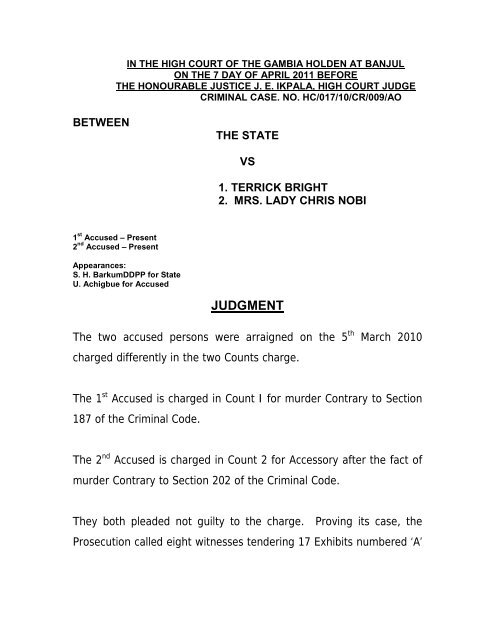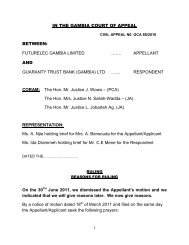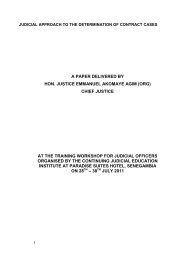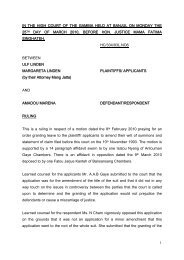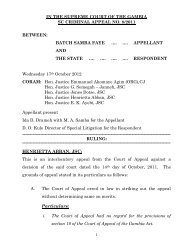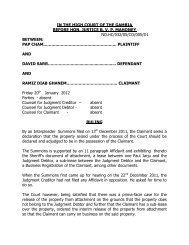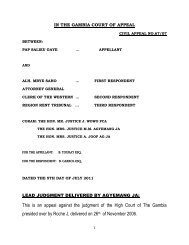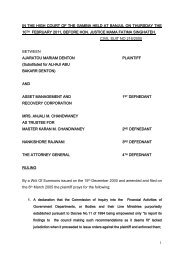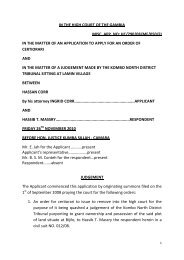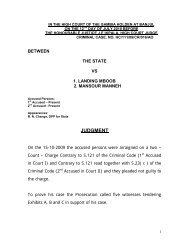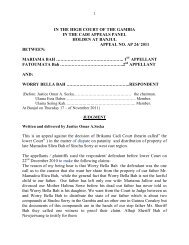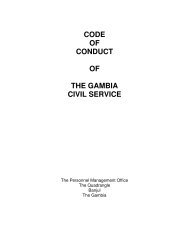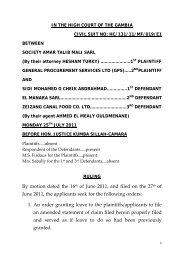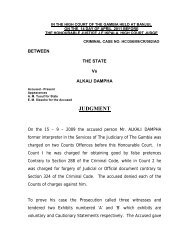IN THE HIGH COURT OF THE GAMBIA HOLDEN AT BANJUL
IN THE HIGH COURT OF THE GAMBIA HOLDEN AT BANJUL
IN THE HIGH COURT OF THE GAMBIA HOLDEN AT BANJUL
You also want an ePaper? Increase the reach of your titles
YUMPU automatically turns print PDFs into web optimized ePapers that Google loves.
<strong>IN</strong> <strong>THE</strong> <strong>HIGH</strong> <strong>COURT</strong> <strong>OF</strong> <strong>THE</strong> <strong>GAMBIA</strong> <strong>HOLDEN</strong> <strong>AT</strong> <strong>BANJUL</strong><br />
ON <strong>THE</strong> 7 DAY <strong>OF</strong> APRIL 2011 BEFORE<br />
<strong>THE</strong> HONOURABLE JUSTICE J. E. IKPALA, <strong>HIGH</strong> <strong>COURT</strong> JUDGE<br />
CRIM<strong>IN</strong>AL CASE. NO. HC/017/10/CR/009/AO<br />
BETWEEN<br />
<strong>THE</strong> ST<strong>AT</strong>E<br />
VS<br />
1. TERRICK BRIGHT<br />
2. MRS. LADY CHRIS NOBI<br />
1 st Accused – Present<br />
2 nd Accused – Present<br />
Appearances:<br />
S. H. BarkumDDPP for State<br />
U. Achigbue for Accused<br />
JUDGMENT<br />
The two accused persons were arraigned on the 5 th March 2010<br />
charged differently in the two Counts charge.<br />
The 1 st Accused is charged in Count I for murder Contrary to Section<br />
187 of the Criminal Code.<br />
The 2 nd Accused is charged in Count 2 for Accessory after the fact of<br />
murder Contrary to Section 202 of the Criminal Code.<br />
They both pleaded not guilty to the charge. Proving its case, the<br />
Prosecution called eight witnesses tendering 17 Exhibits numbered ‘A’
– Q. The accused gave evidence in their defence and tendered three<br />
(3) Exhibits. They did not call any witness.<br />
There is no eye witness and Pw1, – Pw5 and Pw8 are Police Officers<br />
involved in the investigation. Pw6 and Pw7 are relative and friend of<br />
the deceased Amie Bah. Exhibit Q, Statement of the 1 st Accused in<br />
two parts is confessional though he tried to retract it in his oral<br />
testimonies in Court, or impugned its voluntariness.<br />
The summary of the case of the Prosecution is that on the 16 th day of<br />
September 2009 the body of the deceased Amie Bah was found on<br />
the street of Latrikunda with Cello tape wrapped all over her mouth<br />
and nose. The police called at the house of the accused persons, the<br />
1 st Accused being a boyfriend of the deceased and the deceased<br />
being there the previous day with the accused persons for a<br />
transaction concerning her younger sister Mariam Bojang. The Police<br />
recovered Cello tape which resembles the type wrapped over the<br />
mouth and nose of the deceased as well as posters which same Cello<br />
tape was used to paste the wall of the 1 st Accused person. The<br />
Medical Report gave the cause of death as –“Deep Asphyxia due to<br />
air way obstruction”. The 1 st Accused made a confessional Statement<br />
in which he implicated the 2 nd Accused person.<br />
For the 1 st Accused case, he last saw the deceased his girlfriend on<br />
the 14 th September 2009 when they were together but did not see
her when she called again in the house on the 15 th – September<br />
2009 but was so informed by the 2 nd Accused. He said though he<br />
and the deceased agreed to meet on the 16-9-2009, he waited<br />
indefinitely without seeing her till he was arrested at midnight by the<br />
Police and the Police did not tell him why he was being arrested. In<br />
one breath, he denied making the confessional statement Exhibit ‘Q’<br />
and in another breath he said it was made under-duress.<br />
For the 2 nd Accused, after the introduction, and prompted by her<br />
Counsel, she said she is adopting her extrajudicial statement to the<br />
Police Exhibit ‘P’.<br />
At the end of their respective cases, they settled for written<br />
argument. The Defence filed a 3 unnumbered pages argument on<br />
the 26 th January, 2011 while the Prosecution filed 16 pages argument<br />
on the 9 th February 2011 where he formulated 6 issues though<br />
labeled arguments.<br />
These are:<br />
• Whether the death of human being has taken place?<br />
• Whether such death was caused (sic) the accused<br />
person?
• Whether the accused knew that death would be the<br />
probable consequence of his act?<br />
• Whether the Court can convict on the resiled confession<br />
of accused person?<br />
• Whether the act was done with intention of causing<br />
death?<br />
• Whether the 2 nd Accused person had access to the fact<br />
of the murder?<br />
See page 7 of Prosecution argument. I shall not reproduce the<br />
arguments canvassed by Counsel but references would be made to<br />
the high points raised therein, in the cause of this Judgment.<br />
Count I<br />
Only the 1 st Accused is charged under this count which Court is<br />
murder Contrary to S. 187 of CC. The particulars of the offence<br />
stated thus:<br />
“Terrick Bright on or about the 16 th day of<br />
September, 2009 at Latrikunda German in the<br />
Kanifing Municipality within the Jurisdiction of this<br />
Honourable Court unlawfully caused the death of
Amie Bah by hitting her on the neck and sealing<br />
her mouth and nose with Cello tape knowing that<br />
death would be Probable consequence of such act<br />
and thereby committed an offence”.<br />
For the Prosecution to establish murder he will need to prove beyond<br />
reasonable doubt not only that the accused caused the death of the<br />
deceased Amie bah but that he did so with the requisite intent.<br />
See AJOSE V ST<strong>AT</strong>E (2002) 7NWLR (pt. 766)302 at 319.<br />
AK<strong>IN</strong>YEMI V ST<strong>AT</strong>E (1999)6NWLR (pt. 607)449 at 469<br />
Crim CASE No. HC/310/09/CR/09 IGP V OUSMAN MORO<br />
DEMBA<br />
Unreported dated 13-12-2010 Per Ikpala J.<br />
The Prosecution can achieve proof beyond reasonable doubt by any<br />
of the following four ways:<br />
• By direct and positive evidence from eye witness or witnesses<br />
who watch the accused hacked or killed the deceased Amie<br />
Bah.<br />
See HOUSA V ST<strong>AT</strong>E (1992)1NWLR (pt. ………)612.<br />
• ITEDJERE V ST<strong>AT</strong>E (1984)9SC. 59 at 62.
• By confession of the accused person that he killed the deceased<br />
Amie Bah and which confession appears to the Court to be<br />
true.<br />
See ACHABUA V ST<strong>AT</strong>E (1976)12SC 63.<br />
• ABASI V ST<strong>AT</strong>E (1992)8BWKR (pt. 260)383 at 398.<br />
• By circumstantial evidence which points irresistibly to the<br />
commission of the offence by the accused thereby leaving no<br />
room for conjectures or ground for reasonable doubt.<br />
See AJOSE V ST<strong>AT</strong>E (2002)7NWLR (pt. 766) 302 at 320<br />
• ESAI V ST<strong>AT</strong>E 11SC.39<br />
• By the combination of (1) and (2) above, a Proof described as<br />
ex-abundanti cautela.<br />
See <strong>THE</strong> LAW <strong>OF</strong> EVIDENCE 2 nd EDITION<br />
Hassan B. Jallow at Page 21.<br />
ABASI V ST<strong>AT</strong>E Supra at 404.<br />
Meanwhile that requisite intent described as Malice aforethought<br />
under S.187 of CC is statutorily defined under S.190 of CC and is<br />
established under the follow situations:<br />
• Where there exists intention to cause death or do<br />
grievous harm.
• Where there exists knowledge that the act or omission<br />
would cause death or grievous harm.<br />
• Where there exists the use of violent measures in the<br />
commission at or attempt at a felony.<br />
• Where there exists an intention by the act or omission<br />
to facilitate the flight or escape from custody any<br />
person who has committed or attempted to commit a<br />
felony.<br />
It follows that the resume of burden of Proof on the Prosecution are:<br />
• that the accused person caused the death of the<br />
deceased.<br />
• that the killing was unlawful.<br />
• that the accused person had the intention to cause the<br />
death of the deceased or cause her bodily harm.<br />
See AK<strong>IN</strong>YEMI V ST<strong>AT</strong>E Supra at 469.
In my humble view the 6 issues formulated by the Prosecution can<br />
be subsumed into four namely:<br />
• Whether the accused caused the death of the deceased<br />
Amie Bah<br />
• Whether the killing was unlawful<br />
• Whether the accused had the intention to cause her<br />
bodily harm<br />
• Whether the retraction by the 1 st<br />
confessional statement Exhibit ‘Q’ is material.<br />
Accused of his<br />
ISSUE 1<br />
Let me repeat that there is no eye witness or witnesses in this case<br />
so such method of Proof is not available to the Prosecution. To the<br />
Prosecution, the evidence are both confessional Exhibit ‘Q’ and<br />
circumstantial that the accused caused the death of the deceased.<br />
To the defence as per page 1 of their argument “……… The evidence<br />
against the accused persons are mainly circumstantial that are not<br />
strong enough to establish the guilt of the Accused person”.
S. 31(1) of the Evidence Act 1994 define confession as a voluntary<br />
admission made at anytime by a person charged with a crime, stating<br />
or suggesting the inference that he committed that crime.<br />
Exhibit ‘Q’ the voluntary statement of the accused dated 25-9-2009 is<br />
in two parts. The second past is titled “ADDITIONAL ST<strong>AT</strong>EMENT”.<br />
The first part is comprehensive as to how the deceased was killed<br />
and disposed off sole by the accused person. The 2 nd part deals<br />
essentially on how the 2 nd Accused assisted him to dispose the body<br />
of the deceased. This will be considered in Count 2.<br />
The law is trite that a free and voluntary confessional statement<br />
alone properly taken, tendered and admitted and proved to be true is<br />
sufficient to support a conviction provided it satisfies the 6 tests<br />
enunciated in<br />
R V SYKES (1993) 8 Cr. APP. Report 333.<br />
OBASI V ST<strong>AT</strong>E Supra at 398.<br />
The 6 tests to look out for in a confessional statement can be<br />
summarise as follows:<br />
• Is there anything outside the confession to show that it<br />
is true?<br />
• Is it corroborated?
• Are the relevant statements of fact made in it true as<br />
far as can be tested?<br />
• Was the accused one who had the opportunity to<br />
commit the offence?<br />
• Is the confession possible?<br />
• Is it consistent with other facts which have been<br />
ascertained?<br />
See AMOSHIMA V ST<strong>AT</strong>E<br />
(2009) 4 N CC 280 at 345<br />
NS<strong>OF</strong>OR V ST<strong>AT</strong>E<br />
(2004) 18 NWLR (pt. 905)292 at 310 – 311<br />
In addition to the positive and direct confession of the accused in<br />
Exhibit ‘Q’ other relevant evidence and circumstance that accord with<br />
the Exhibit ‘Q’ are:<br />
In Exhibit ‘Q’ the accused described the deceased as wearing a white<br />
top upon a Jean trousers and Exhibits ‘L’ photos of the deceased long<br />
evacuated before the accused made Exhibit ‘Q’ shows that the<br />
deceased was on a white top upon a Jean Trousers.
In Exhibit ‘Q’ the accused said he used a brown Cello tape Exhibit ‘M’<br />
to seal the mouth and nose of the decease to stop her from<br />
breathing heavily and making a noise he does not like. The same<br />
type of Cello tape was seen used to paste posters Exhibit ‘D’<br />
recovered in the house of the accused as well as Exhibit ‘G’.<br />
In Exhibit Q the accused said he struck the deceased with his silver<br />
bangle worn on his wrist and the same<br />
without objection.<br />
admitted as Exhibit ‘F’<br />
In Exhibit ‘Q’ the accused said he sealed the mouth and nose of the<br />
deceased with Exhibit M and Exhibit ‘R’ the Medical Report give the<br />
cause of death as “Deep asphyxia due to airway obstruction which of<br />
course is the consequence of sealing ones mouth and nose.<br />
In Exhibit ‘Q’ the weaponry of the murder are silver bangle and the<br />
Cello tape and both were recovered as Exhibits ‘F’ and M respectively.<br />
Finally I hold that Exhibit ‘Q’ is a confession and did establish that the<br />
accused caused the death of the deceased Amie Bah. Issue 1 is<br />
therefore resolved in favour of the Prosecution.
ISSUE 2<br />
The answer to this issue is in the affirmative, that is to say, the killing<br />
of the deceased Amie Bah by the accused is unlawful. This is<br />
because no iota of evidence is before this Court to justify the killing.<br />
Lawful killing takes place if ordered by the Court to the appropriate<br />
authority and in this case, there is no evidence that it was ordered or<br />
that the accused is an appropriate authority. See SS. 27(a) and<br />
28(1) of the Criminal Code.<br />
Finally, I resolve this issue in favour of the Prosecution.<br />
ISSUE 3<br />
This issue is very crucial or central that I need to repeat it. It is<br />
whether the accused had the intention to cause the death of the<br />
deceased or caused her bodily harm? The centrality of this issue is<br />
better expressed in the Latin maxim – actus non facit reum nisi<br />
mens sit rea - “an act does not make a person guilty unless his<br />
mind is guilty.”<br />
The question is how guilty is the mind of the accused in the killing of<br />
the deceased Amie Bah. The Prosecution at Pages 13 – 14 of his<br />
argument urged me to presume amongst other things that the<br />
accused intended the consequence of his act when he struck the
deceased with his wrist silver bangle Exhibit ‘F’ to the ground and<br />
proceeded to wrap up her mouth and nose together and which<br />
according to Exhibit ‘R’ Medical Report caused the deceased – Deep<br />
asphyxia due to airway obstruction. He cited GARBA V <strong>THE</strong><br />
ST<strong>AT</strong>E (2002) 2SC NQR 402.<br />
The Defence who never formulated issues, did not join issues with<br />
the Prosecution, not even on rejoinder on point of law. The<br />
argument of the Defence is floating without radar. It did not<br />
highlight the ingredient of the offence of murder which he claims the<br />
Prosecution has failed to prove. He did not use the ones highlighted<br />
by the Prosecution yet in conclusion the defence at Page 2 submitted<br />
thus:<br />
“The Court is therefore urged to discharge and acquit the Accused<br />
persons on all the Counts for the ingredients of murder have not<br />
been established against them”.<br />
Lest we forget, only the 1 st Accused is charged for murder, therefore<br />
that conclusion by the defence is misleading. Back to the guilty mind<br />
of the accused or otherwise, this can be ascertained from Exhibit ‘Q’<br />
being the crux of the Prosecution case. It appears it does not matter<br />
that the accused is trying to retract from it. This is because the Law<br />
is settled that a Court is entitled to make finding from all the
evidence place before it though it was not specifically relied upon as<br />
a defence.<br />
See BULLARD V <strong>THE</strong> QUEEN<br />
(1957) 42 Cr. APP. R1 at 5.<br />
The accused is not disentitled for the consideration of this defence by<br />
mere reason that he denied in his evidence on oath in Court.<br />
See APPIAN<strong>IN</strong>G V <strong>THE</strong> REPUBLIC<br />
(1972) 1GLR.123<br />
According to Exhibit ‘Q’ a quarrel ensued between the accused and<br />
his girl friend the deceased with each accusing the other of infidelity<br />
and it got to a crescendo when the accused specifically referred to a<br />
boy to the annoyance of the deceased who retorted “he is ten times<br />
better than you” – this time to the anger of the accused who reacted<br />
by hitting the deceased with his bangle wrist causing her to fall down<br />
and began breathing heavily. For clarity purpose, I hereby lift that<br />
portion of Exhibit ‘Q’.<br />
“At about 1100hrs she came to my place. She is dressed<br />
in a jean trouser and white top. After few minutes, she<br />
started alleging that I was dating with Binta Gibba which<br />
was not true. She said because of that reason, she also<br />
date with wily. I also told her that she had been lying<br />
about one class mate which I found out and realize was
not true. I asked her about that and she became angry<br />
and said –“he is ten times better than you”. This class<br />
mate was Saidou. I was also angry about that statement<br />
and hit on her neck at the right side. I was wearing some<br />
bangles by the time. She fell down and was breathing<br />
very heavily and making noise like “Uuth”. I left and sat<br />
at the palour. She was still making the noise. I was and<br />
took my remaining Cello tape from my bedroom and<br />
cover her mouth and nose together in order to stop the<br />
noise. This happened at around after mid day (1200hrs).<br />
After when I did that, the noise and breathing stopped<br />
altogether. After that I was very afraid. I did not inform<br />
any one.<br />
----------------------------------------------------------------------<br />
----------------------------------------------------------------------<br />
-------------“<br />
From the above, can we say the Prosecution has establish malice<br />
aforethought within the meaning of S.190(a) or (b) of the Criminal<br />
code. The evidence of Pw6 and Pw7 show a conviviality of a<br />
relationship between the accused and the deceased. On the 14 th and<br />
15 th September 2009, the deceased and her younger sister Mariama<br />
Bojang were with the 2 nd accused for the transaction of securing<br />
admission for the kid in the 2 nd Accused’s School, above all the 1 st<br />
Accused has consistently referred to the deceased as a girlfriend. A
question that beg for an answer is whether there exist intention to<br />
cause death or do grievous harm or knowledge that death or<br />
grievous harm would result when the accuse struck the deceased<br />
with his bangled hand by the neck? My answer is in the negative,<br />
because in my view, the strike by the accused is intended to register<br />
a protest of comparing him with his rival. This explained why he left<br />
the deceased on the ground to sit at the palour. The follow-up<br />
question is when the accused returned from the parlour to wrap up<br />
the mouth and nose of the deceased, was that in furtherance of the<br />
earlier strike on the deceased! If it were, malice aforethought would<br />
have been established. The answer is in the negative as the covering<br />
of the mouth and nose is in the view of the accused to arrest the<br />
noise. It is a smack of naiveness by the accused without malice<br />
undertone. The Prosecution referred me to the case GARBA V <strong>THE</strong><br />
ST<strong>AT</strong>E Supra and urged me to pressure in favour of the Prosecution.<br />
Am afraid I will not because of the factual difference. The murder<br />
weapon used in GARBA V <strong>THE</strong> ST<strong>AT</strong>E and the way and manner it was<br />
used coupled witt the age of the accused leaves the Court with no<br />
other presumption than he intended the natural cause of his act.<br />
Finally I hold that this issue is not established as I resolve it in favour<br />
of the accused.<br />
ISSUE 4
The statement of the Accused has been adjudged confessional and<br />
so admitted as Exhibit ‘Q’. In Court and on oath in one breath, the<br />
accused deny making Exhibit ‘Q’ and in another breath he made it<br />
under torture of various kinds. This was contested during trial –<br />
within trial and ruled in favour of the admissibility of the statement as<br />
confessional. The defence dissipated his energy by repeating the<br />
argument all over. It is trite law that mere repetition of an argument<br />
does not improve an earlier arid, weak, or completely unacceptable<br />
argument.<br />
See. I. F. Ogbuagu Jsc in<br />
OGBU V ST<strong>AT</strong>E<br />
29 NSC QR 222 at 250.<br />
CALABA EAST CO-OPER<strong>AT</strong>IVE THRIFT & CREDIT SOCIETY LTD<br />
VS<br />
ETIM E. IKOT<br />
(1999)12 SCNJ. 321 at 339 Per Achike JSC.<br />
At any rate, the fact that the accused retracted his confessional<br />
statement during his testimony in Court does not make it<br />
inadmissible or that the trial court should not act on it.<br />
See SHADE V ST<strong>AT</strong>E<br />
22 NSCQR. 756 at 765 – 766<br />
AMOSHIMA V ST<strong>AT</strong>E<br />
(2009) 4 NCC 280 at 344
This issue is established and resolved in favour of the Prosecution.<br />
Finally and on the strength of the evidence before me in Proof of<br />
Count I, I find the 1 st Accused not guilty of Murder but guilty of<br />
Manslaughter Contrary to S.186 of the Criminal Code.<br />
COUNT 2<br />
Only the 2 nd Accused is charged under this Count. She is charged<br />
under S.202 of the Criminal Code. The particulars of the offence<br />
read thus:<br />
“Mrs. Lady Chris Nobi on or about the 16 th day of<br />
September 2009 at Latrikunda German in the Kanifing<br />
Municipality within the jurisdiction of this Honourable<br />
Court assisted Terrick Bright to dispose the Corpse of<br />
Amie Bah and thereby committed an offence.”<br />
The Prosecution in issue 6 formulated thus:<br />
Whether the 2 nd Accused Person had access to the fact of<br />
the murder.<br />
Meanwhile S.202 of the Criminal code creates the offence of<br />
Accessory after the fact to murder thus:
S.202 CC.<br />
“Any person who becomes an accessory after the fact to<br />
murder is guilty of a felony, and is liable to imprisonment<br />
for life”.<br />
The Prosecution at Page 15 of his argument conceded that the 2 nd<br />
Accused did not confess in her statement to the Police Exhibit ‘P’ but<br />
urge me to note the testimony of Pw1, and the recovered Exhibit ‘H’<br />
cloth of 2 nd Accused. Let me also add that there is no eye witness or<br />
witnesses. However, I do not understand the submission of the<br />
learned DDPP below and would want to lift it in my record just as it<br />
is.<br />
At Page 15 lines 10 - 15 it is argued thus: -“The evidence of Pw3 and<br />
Pw4, who were led to the scene by the 1 st Accused in company of the<br />
2 nd Accused and the evidence given in her defence are invigorating<br />
factors to the confession of the 1 st accused where he narrated how<br />
he confided in her and the kind assistance she rendered to dump up<br />
the body”.<br />
I had earlier said there is no eye witness. Pw1 – Pw8 are Police<br />
Officers involved in investigation. The case of the Prosecution is<br />
essentially on Exhibit ‘Q’ the confessional statement of the 1 st<br />
Accused. Exhibit Q is in two parts. In the first part, the 1 st accused<br />
narrated how he solely killed and disposed of the body of the
deceased. He never mentioned the 2 nd Accused. In the second part<br />
of Exhibit ‘Q’ titled ADDITIONAL ST<strong>AT</strong>EMENT, the 1 st accused went<br />
haywire and systematically implicated the 2 nd Accused person. I have<br />
read Exhibit ‘Q’ over and over and found that part 2 of it did not flow<br />
consequentially from the first part. It is mendacious. It is a<br />
concoction. This is because, in the first part of Exhibit ‘Q’, the 1 st<br />
Accused gave account of how the body of the deceased was disposed<br />
thus:<br />
“At about 2100hrs, I placed her body (Amie) on my<br />
back catching both legs and went up to the corner<br />
before my junction and dropped the body there<br />
(Latrikunda German). The body was placed facing<br />
downwards. I placed the plastic bag besides her<br />
containing her shoe, purse and head tie. I then<br />
walked to my room”.<br />
The first part of Exhibit ‘Q’ cover three pages of a chronological<br />
account which is conclusive as it were.<br />
The second part of Exhibit ‘Q’ cover 1¼ pages is without preamble<br />
and appeared to be designed for a specific purpose i.e implicate the<br />
2 nd Accused person only. I reject it.
Furthermore, it is contended on behalf of the 2 nd Accused that I be<br />
wary of Exhibit ‘Q’ since it proceeded from a co-accused, and there is<br />
no corroboration. I did not find a reply by the Prosecution to this<br />
serious point of law raised by the defence. While I agree with the<br />
defence that a confession of one accused implicating the other is<br />
inadmissible against that other accused except he adopts it, I do not<br />
agree that corroboration would safe that fundamental defect as<br />
contended by Counsel.<br />
See S.32(2) of the Evidence Act 1994. I reject part 2 of Exhibit Q<br />
or Additional Statement of the 1 st Accused as it is designed only to<br />
implicate the 2 nd Accused person.<br />
In EDEM AKPAN AKPO & ANOR VS <strong>THE</strong> ST<strong>AT</strong>E (1994)1 ALL NLR 369<br />
an accessory after the fact is said to be one helping the culprit to<br />
escape punishment. I find no iota of evidence in Proof of this Count.<br />
Exhibit ‘H’ cloth of the 2 nd Accused has no nexus to the commission<br />
of the offence. This is more especially when it is realize that the<br />
Exhibit ‘H’ was not even described in Exhibit ‘Q’. In the light of the<br />
above, I find Count 2 not proved and the 2 nd Accused is acquitted<br />
and discharged.<br />
For the 1 st Accused I find evidence overwhelming that he<br />
unintentionally killed Miss Amie Bah his girlfriend and find him guilty<br />
of Manslaughter.
Allocutus:<br />
Court:<br />
1 st Accused, what have you or your Counsel to say before<br />
sentence is passed on you?<br />
1 st Accused:- Apart from God, my life is in your hand.<br />
You may liberate me or condemn me.<br />
Defence Counsel:<br />
He is a victim of circumstances. A young<br />
man caught in naiveness. I urge you<br />
temper justice with mercy by imposing<br />
minimal sentence as not to eclipse his<br />
potentials.<br />
Prosecution:<br />
No record about his conviction and thank my lord<br />
for the judgment.<br />
Court:<br />
Young lovers should know that It takes majority to<br />
appreciate the up and down of a love life. I have<br />
taken note of the plea of the convict and his<br />
Counsel and noted too that the deceased Amie Bah<br />
is gone and will not have another opportunity to<br />
evaluate her relation. She deserves justice even in<br />
her grave. Consequently the accused will be<br />
punished appropriately.
Sentence:<br />
Court:- 1 st Accused you are sentence to 10yrs<br />
imprisonment.<br />
You are reminded of your right of appeal.<br />
J. E. Ikpala<br />
JUDGE<br />
7 - 4 - 2011


